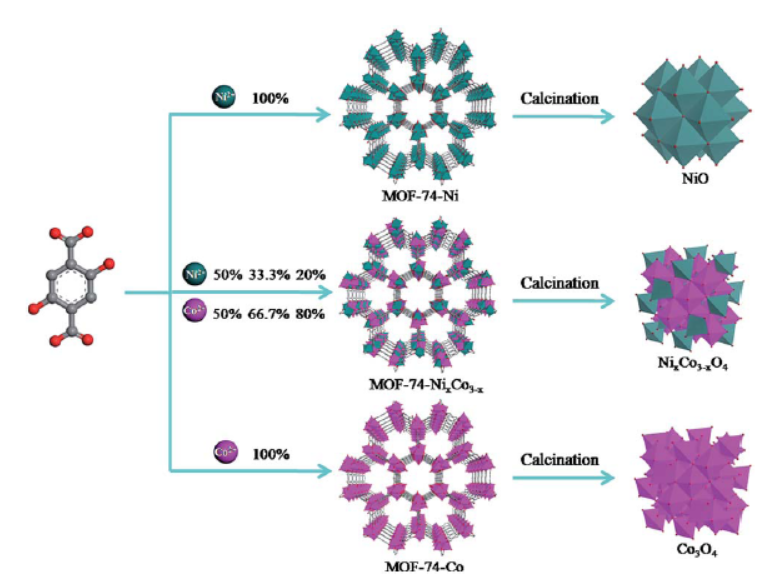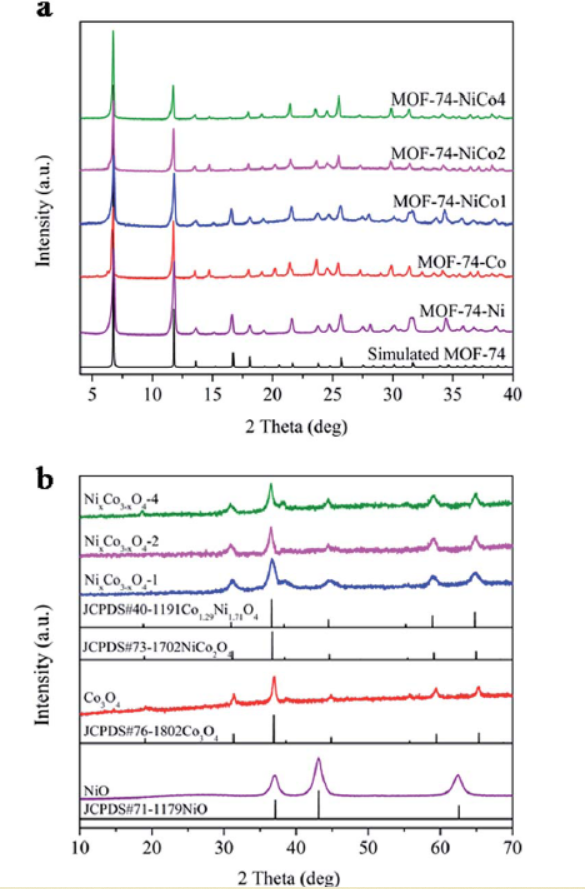Home >
News > MOF-74-derived NixCo3−xO4 for supercapacitors
MOF-74-derived NixCo3−xO4 for supercapacitors
Summary:
The authors from Jilin University’s State Key Laboratory of Inorganic Synthesis and Preparative Chemistry developed NixCo3−xO4 nanoparticles (Ni/Co = 1:1) with 797 F g−1 capacitance and 80 % retention after 10 000 cycles, achieving record-high performance in supercapacitor electrodes.

Background:
1. To boost pseudocapacitor energy density, previous works synthesized NiCo2O4 via sol–gel or electrochemical routes, yet precise metal-ratio control, high surface area and long cycle life remain elusive.
2. The authors proposed a MOF-74-template calcination strategy that delivers composition-tunable NixCo3−xO4 with ultrafine 10 nm grains and mesoporous architecture.
Research Content:
1. Synthesis:
Five isostructural MOF-74 crystals (Co, Ni, NiCo1, NiCo2, NiCo4) were solvothermally grown, then air-calcined at 400 °C (1 °C min−1) to yield pure-phase spinel NixCo3−xO4.
2. Characterizations:
1) BET 64–117 m² g⁻¹; mesopore ~3–5 nm.
2) SEM/TEM show 20–50 µm secondary particles built from 10 nm primary grains; HR-TEM d(111)=0.47 nm.
3) XPS confirms rich Ni³⁺/Co³⁺; EIS: 0.26 Ω series resistance for NixCo3−xO4-1.
3. Application:
6 M KOH three-electrode cell: 797 F g⁻¹ at 1 A g⁻¹, 597 F g⁻¹ at 20 A g⁻¹ (75 % rate); 80 % capacitance after 10 000 cycles at 10 A g⁻¹; energy density 27.7 W h kg⁻¹ at 250 W kg⁻¹.
4. Mechanism:
Ni³⁺-rich surface facilitates NiOOH redox; bimetallic synergy lowers electron-transfer activation energy; mesoporous 10 nm network shortens ion paths and buffers volume swings.

Outlook:
The MOF-derived composition-programmable route produces scalable, phase-pure NixCo3−xO4 that outperforms literature NiCo2O4, offering a universal platform for high-rate, stable energy-storage oxides.
Rational design and synthesis of NixCo3−xO4 nanoparticles derived from multivariate MOF-74 for supercapacitors
Authors: Siru Chen, Ming Xue, Yanqiang Li, Ying Pan, Liangkui Zhu, Shilun Qiu
DOI: 10.1039/C5TA02557E
Link: https://pubs.rsc.org/en/content/articlelanding/2015/ta/c5ta02557e
The above review is for academic progress sharing. For any errors or copyright issues, please contact us for correction or removal.

